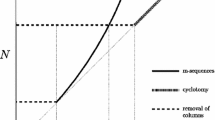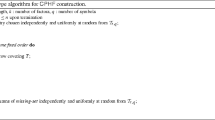Abstract
A covering array \(\text{ CA }(N;t,k,v)\) is an \(N\times k\) array such that in every \(N\times t\) subarray each possible t-tuple over a v-set appears as a row of the subarray at least once. The integers t and v are respectively the strength and the order of the covering array. Let v be a prime power and let \({\mathbb {F}}_v\) denote the finite field with v elements. In this work the original concept of permutation vectors generated by a \((t-1)\)-tuple over \({\mathbb {F}}_v\) is extended to vectors generated by a t-tuple over \({\mathbb {F}}_v\). We call these last vectors extended permutation vectors (EPVs). For every prime power v, a covering perfect hash family \(\text{ CPHF }(2;v^2-v+3,v^3,3)\) is constructed from EPVs given by subintervals of a linear feedback shift register sequence over \({\mathbb {F}}_v\). When \(v\in \{7,9,11,13,16,17,19,23,25\}\) the covering array \(\text{ CA }(2v^3-v;3,v^2-v+3,v)\) generated by \(\text{ CPHF }(2;v^2-v+3,v^3,3)\) has less rows than the best-known covering array with strength three, \(v^2-v+3\) columns, and order v. CPHFs formed by EPVs are also constructed using simulated annealing; in this case the results improve the size of eighteen covering arrays of strength three.


Similar content being viewed by others
References
Aarts E., Lenstra J.K. (eds.): Local Search in Combinatorial Optimization. Wiley, New York (1997).
Colbourn C.J.: Covering array tables for \(t=2,3,4,5,6\). Accessed 16 Aug 2017 (2017). http://www.public.asu.edu/~ccolbou/src/tabby/catable.html.
Hartman A.: Software and hardware testing using combinatorial covering suites. In: Golumbic M.C., Hartman I.B.A. (eds.) Graph Theory, Combinatorics and Algorithms: Interdisciplinary Applications, Operations Research/Computer Science Interfaces Series, vol. 34, pp. 237–266. Springer, Boston (2005).
Kuhn D.R., Kacker R.N., Lei Y.: Sp 800-142. practical combinatorial testing. Technical Report, National Institute of Standards and Technology, Gaithersburg, MD (2010).
Lidl R., Niederreiter H.: Introduction to Finite Fields and Their Applications. Cambridge University Press, New York (1986).
Raaphorst S., Moura L., Stevens B.: A construction for strength-3 covering arrays from linear feedback shift register sequences. Des. Codes Cryptogr. 73(3), 949–968 (2014).
Sherwood G.B., Martirosyan S.S., Colbourn C.J.: Covering arrays of higher strength from permutation vectors. J. Combin. Des. 14(3), 202–213 (2006).
Torres-Jimenez J., Rodriguez-Tello E.: New bounds for binary covering arrays using simulated annealing. Inf. Sci. 185(1), 137–152 (2012).
Tzanakis G., Moura L., Panario D., Stevens B.: Constructing new covering arrays from LFSR sequences over finite fields. Discret. Math. 339(3), 1158–1171 (2016).
Walker II R.A., Colbourn C.J.: Tabu search for covering arrays using permutation vectors. J. Stat. Plann. Inference. 139(1), 69–80 (2009). Special Issue on Metaheuristics, Combinatorial Optimization and Design of Experiments.
Acknowledgements
The authors acknowledge the General Coordination of Information and Communications Technologies (CGSTIC) at CINVESTAV for providing HPC resources on the Hybrid Cluster Supercomputer “Xiuhcoatl”, which contributed to the research results reported here. The research reported in this paper was funded through the following projects: CONACYT - Métodos Exactos para Construir Covering Arrays Óptimos, Project Number 238469.
Author information
Authors and Affiliations
Corresponding author
Additional information
Communicated by D. Panario.
Rights and permissions
About this article
Cite this article
Torres-Jimenez, J., Izquierdo-Marquez, I. Covering arrays of strength three from extended permutation vectors. Des. Codes Cryptogr. 86, 2629–2643 (2018). https://doi.org/10.1007/s10623-018-0465-6
Received:
Revised:
Accepted:
Published:
Issue Date:
DOI: https://doi.org/10.1007/s10623-018-0465-6
Keywords
- Covering arrays
- Extended permutation vectors
- Covering perfect hash families
- Linear feedback shift register sequences




